2.2
Analysis of Results
General Approach by Member Countries
The survey asked whether a national
biodiversity coordinating body, assembly or committee had been
established to follow up the Convention. Establishment of such a
body was not required by the Convention, but was an approach
adopted by many Contracting Parties. Furthermore, the survey
asked whether national strategies, plans or programmes for the
conservation and sustainable use of biological diversity had been
developed or were planned, and whether it was intended to adapt
an existing strategy.
Ten out of 17 countries had a formal
biodiversity coordinating body (see Figure 2), but most countries
had no clearly identifiable budget. The terms of reference for
the coordinating body were, for example, to implement the
objectives of the Convention (Finland), development
of a national strategy (Austria), implementation and
coordination (Netherlands); developing costed targets
and recommending ways ... (UK). The
exception was Ireland, where the terms of reference were to
consider the implications of the Convention for Government
Departments. Most countries intended to adapt or use
existing legislation in order to meet obligations under the
Convention, where possible.
Article 6 General Measures for
Conservation and Sustainable Use
Five countries had national strategies in
place at the time of completing the survey, and of the 10 which
were developing strategies all but two expected these to be
completed by the end of 1997. Most countries intended to use
legislation already in place. Only three countries already had
national action plans in operation, five were developing them,
and the remainder stated this as a future priority (see Figure 2).
All sixteen countries had integrated, or intended to integrate,
conservation and sustainable use of biological diversity into
relevant sectoral or cross-sectoral plans. Environment,
agriculture, forestry and fisheries and aquaculture were the
sectors perceived to be have the greatest priority in this
respect (see Figure 3).
Figure 2: National strategies
and plans
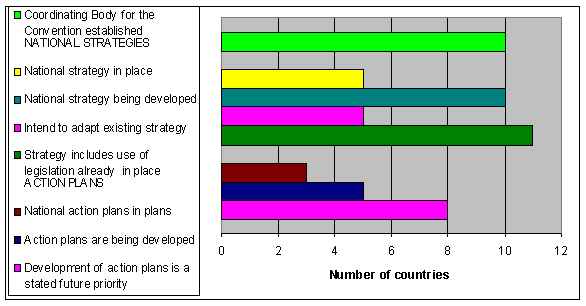
Figure 3: Government sectors
integrated into sectoral or cross-sectoral plans
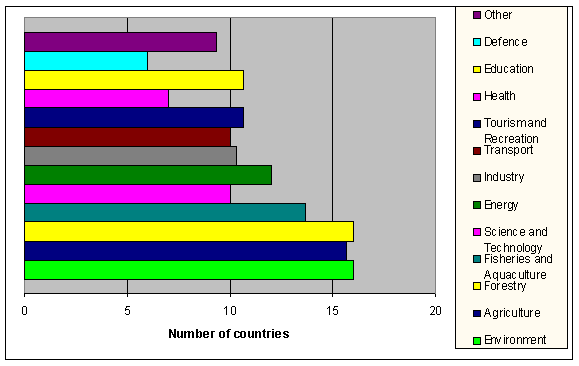
In drawing up national strategies and
plans, Contracting Parties are required to consult widely. In the
survey, respondents were asked for the names and roles of
prominent major groups or non-governmental organisations (NGOs)
participating in the development of biodiversity action plans. It
appeared that the interests of business and industry had been
given greater priority than (for example) farming and fishery
interests. However, as might be expected, environmental NGOs and
the scientific and technological community were the most widely
involved (see Figure 4). The amount of governmental financial
support to national biodiversity efforts of the groups and NGOs
involved was extremely variable. All but two of the sixteen
countries had made a financial commitment, although five
countries were unable to put an absolute value on their
contribution.
Figure 4: Major official groups and
NGOs participating in development of action plans
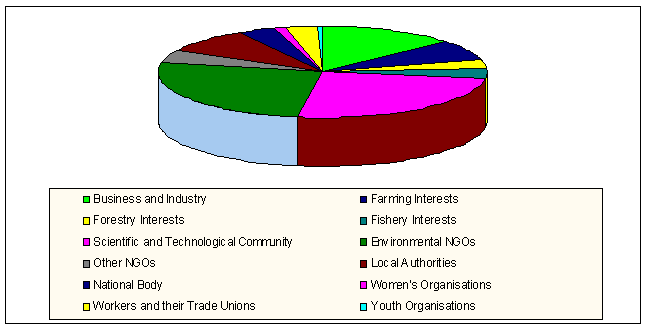
Article 7 Identification and
Monitoring
Only two countries had yet to identify
components of biodiversity (see Figure 5) for which it was
important to consider issues of conservation and sustainable use,
and in both of these countries work was in progress. In the other
countries this activity generally took the form of drawing up
lists of key species and habitats, or red lists of species. Only
one country reported a red list of habitats, and one was
undertaking a "hotspots" analysis to determine greatest
needs.
Monitoring systems had been set up or were
being planned where such components were identified, and these
generally focused either on species or habitats requiring urgent
conservation measures, or on species or habitats which have a
"high profile" in terms of public awareness. More
extensive biodiversity monitoring programmes had yet to be
implemented in most countries. All countries either had
monitoring programmes in place or planned to evaluate processes
or activities likely to have adverse impacts on certain
components of biodiversity. However, in most cases, these impacts
had not been compared with the overall status and trends in
biodiversity. Most countries made use of indicators of
biodiversity or impacts in their monitoring programmes, but
little information was supplied concerning the monitoring
programmes per se. In many cases it was intended to store
information collected in computerised databases, sometimes linked
to geographical information systems, but there was little
agreement over the systems and format best suited to the task.
The setting of specific targets for maintaining biodiversity was
seen to be a useful tool in meeting obligations under the
Convention, but the setting of these targets had been approached
in a wide variety of ways. Nine countries were developing targets
to some extent.
| Figure 5: Identification and
monitoring of components of biodiversity |
Type of components
identified |
 |
 |
Article 8 In-situ
Conservation
Not all aspects of Article 8 were examined
in the survey, but from the replies received it was apparent that
the majority of countries had made considerable progress towards
meeting their obligations (see Figure 6). The establishment of
protected areas was frequently linked to the requirements under
the EU Habitats and Birds Directives and to the consequent
establishment of the Natura 2000 network of protected areas, or
to other previously existing protection schemes. Least progress
had been made towards meeting obligations under Article 8 (h) and
(j): measures to control alien species which threaten ecosystems,
habitats or species, and securing indigenous practices and
knowledge relevant to biological diversity. Fifteen countries had
legislation for the protection of threatened species, and eight
countries had an identifiable budget for in-situ
conservation.
Nine countries reported implementing either
eight or nine of the possible measures under Article 8, but
others reported that they had implemented only one and two
respectively (Figure 7).
Figure 6: In-situ
conservation measures implemented
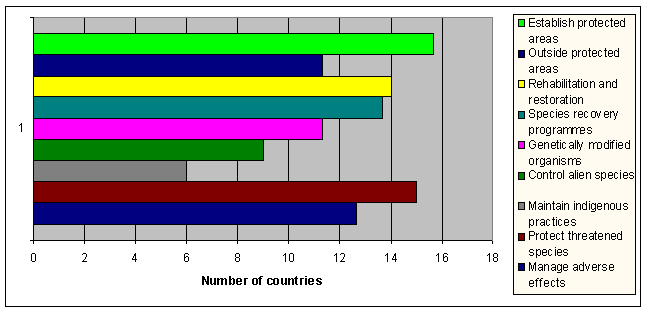
Figure 7: Numbers of in-situ
conservation measures implemented (Maximum 9)

Article 9 Ex-situ
Conservation
All but three countries either had existing
measures, or had plans to incorporate measures concerning ex-situ
conservation in their national action plans. The conservation
measures included tended to be specific to a particular group of
organisms within a particular country, for example, fish, trees
or agricultural grain, and to take the form of gene banks or
breeding programmes. In general, action plans promoted the
extension and development of existing programmes (see Figure 8),
for example, establishing and maintaining research facilities,
measures for the recovery, rehabilitation or reintroduction of
threatened species, or managing collections of biological
resources from natural and semi-natural habitats. In five
countries support was also given to ex-situ conservation
facilities in developing countries. None of the respondents were
able to supply details of a budget allocation: nine countries
gave no response to the financial part of the question, while the
remaining four were either unable to supply details at the time,
or could not separate out this component.
Figure 8: Ex-situ conservation
activities reported
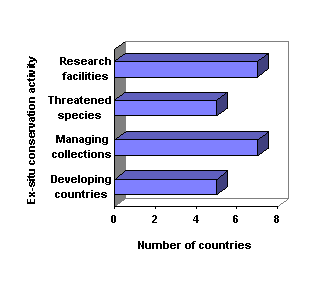
Article 10 Sustainable Use of
Components of Biological Diversity
This Article requires inter alia
that Contracting Parties should integrate consideration of the
conservation and sustainable use of biological resources into
national decision making, and that governments and the private
sector should be encouraged to cooperate in developing methods
for sustainable use.
In most (12 out of 16) countries such
cooperation was encouraged, particularly with respect to
agricultural activities and forestry (see Figure 9), but
cooperation was only linked in any way to sectoral plans in six
countries. Criteria for sustainable use of biological resources
had been established in six countries, and were planned in two
others. These criteria concerned forestry in three countries, and
aquatic systems in another. One country noted the need for
indicators of sustainability.
Figure 9: Parts of the private sector
involved in development of sustainable use

Article 11 Incentive Measures
All but two countries had, or were
developing, specific socio-economic measures to act as incentives
for the conservation and sustainable use of biological resources
(for example, environmental subsidies, agri-environment measures,
farming subsidies), but very few were able to give an actual cost
of these measures. The majority of these incentives were in the
areas of agriculture and forestry. Several countries mentioned
subsidies to encourage more "nature-friendly" farming
methods, sometimes linking this with the EU agri-environment
regulation 2078/92/EEC. Two countries mentioned funding to
provide compensation for damage caused by large predators. In
both Belgium and Germany the measures were being taken at the
regional rather than federal level.
Article 12 Research and Training
Contracting Parties are required to
establish and maintain programmes for scientific and technical
education, and training for the identification, conservation and
sustainable use of biological diversity and its components. Six
countries had set up such programmes specifically to meet their
obligations under the Convention, while three others were in the
process of modifying existing programmes. In two cases existing
programmes had been modified already, while in two further
countries existing training programmes were deemed to be
sufficient to meet obligations. Only two countries were able to
give an actual cost of setting up such programmes. Mechanisms to
encourage research and cooperation in the conservation and
sustainable use of biological diversity existed or were being
developed in 14 out of 15 countries (one did not respond to this
question), but only seven included mechanisms to promote
international cooperation. The needs of developing countries in
this context were specifically taken into account by ten
countries, but in most cases little information was provided as
to the mechanisms involved.
Article 13 Public Awareness and
Education
Respondents were asked whether education
and public awareness was being promoted regionally, nationally or
internationally as part of their plans or strategies. This aspect
received a high priority within each of the responding countries
(with the possible exception of one which did not reply to this
question). All except one intended to promote public awareness
nationally, but only five countries regionally. International
cooperation on this issue had a lower priority, with only four
countries giving a positive answer. It was unclear from several
countries responses whether these public awareness
programmes had been strengthened as a result of the Convention or
had already been in existence.
Article 14 Impact Assessment and
Minimising Adverse Impacts
In all sixteen countries procedures for
environmental impact assessment were already in place, usually
being required by Acts of Parliament (for the Flemish region only
in Belgium). Only four countries specifically mentioned the EU
Directive on Environmental Impact Assessment (85/337/EEC),
although all EU Member States were required to implement this
Directive. Species, habitats or ecosystems were the most
frequently cited components of biodiversity involved, and all
countries used public participation such as public enquiries in
assessment procedures. While 13 countries stated that they were
planning, or already had introduced, means to take environmental
consequences of their programmes and policies into account in
their planning procedures, there was little information and no
examples of how this was to be effected. Most countries were not
taking any action on subsidies which have adverse environmental
consequences: these were being identified and would be phased out
to a greater or lesser extent in three countries; the issue was
being actively considered in one other country.
Considering procedures for notifying
neighbouring states of immediate dangers to their biological
diversity, responses given by many of the countries (with one
exception) suggested that they were unaware of the UN-ECE
Convention on Environmental Impact Assessment in a Transboundary
Context (Espoo Convention of 1991), although all EEA
Member Countries (except Liechtenstein) are parties to this
Convention. This meant that the national responses probably
underestimated the real situation. Eight countries specified that
they had emergency response procedures to deal with activities or
events which presented an imminent danger to biodiversity within
their own borders, often relating specifically to oil spills. 11
countries indicated that they had arrangements in place with
other countries for exchange of information concerning
cross-border impacts on biodiversity (many specifically for
aquatic ecosystems, such as shared rivers, estuaries or marine
waters) and noted formal arrangements under ECE Conventions.
Eight of these countries had some kind of formal agreements for
notifying other states of immediate danger to their biological
diversity, particularly with respect to oil spills, while others
were considering this issue or the use of informal procedures.
Article 15 Access to Genetic
Resources
The aim of this Article is to encourage
access to genetic resources for other Contracting Parties, and to
share the results of scientific research based on genetic
resources. Four countries stated that they currently controlled
access (with a further specific instance of control regarding
endangered species), but only two of these did not intend to
relax such controls to comply with the requirements of the
Convention. Two countries, however, stated that they had measures
to promote the equitable sharing of research results and benefits
arising from the commercial and other utilisation of genetic
resources. Two further countries had proposals for future
measures. Seven countries had, or soon would have, joint
programmes with other states for research on genetic resources,
particularly with respect to commercial crop plants. Three of
these seven responses specifically mentioned research involving
developing countries.
Article 16 Access to and Transfer of
Technology
Access by other states to technologies
relevant to conservation and sustainable use of biological
diversity or genetic resources was promoted in the public sector
by eight countries, and six countries had cooperation with
developing countries (for example, through aid programmes). Only
two countries, however, had measures that required the private
sector to cooperate with government institutions in this respect,
or with the private sector in developing countries; one further
country had voluntary agreements.
Article 17 Exchange of Information
Nine countries facilitated exchange of
information relevant to conservation and biological diversity, or
intended to do so; four countries specifically cited the Clearing
House Mechanism to be set up under the Convention (the pilot
phase of which has been extended to December 1998). Five of the
other countries had not yet elaborated such plans and two did not
respond to the question. Of the nine countries which responded
positively, eight included exchange of the results of technical,
scientific and socio-economic research, as well as information on
training and surveying programmes, specialised knowledge,
indigenous and traditional knowledge.
Article 18 Technical and Scientific
Co-operation
Respondents were asked about their
governments plans for provisions to promote international
technical and scientific cooperation in the field of biological
diversity. The ten countries which gave a definite response all
gave positive replies concerning their obligations for at least
some of the five parts(1) of Article 18. Cooperation
in the field of biodiversity through national and international
institutions and through the training and exchange of expertise
was given the highest priority. Of the remaining six countries,
three were unable to respond to the question since plans had not
been finalised, one made no national response while two did not
make any response to this question at all.
Article 19 Handling of Biotechnology
and Distribution of its Benefits
Regulations for the safe transfer, use and
handling of living modified organisms resulting from
biotechnology which may have adverse effects on biological
diversity had been incorporated into the national plans of seven
countries; by specific Acts in three cases and by implementation
of EU Directives in four. Four more countries had plans under
development. Five had no regulations or did not respond to the
question. Where regulations existed, a register of information
concerning these organisms was kept, or (in one country) was in
preparation. Where regulations were under development, three
countries had no register as yet, but one country did keep
records of organisms notified or approved.
Article 20 Financial Resources
Because of the cross-cutting nature of many
of the issues concerning biodiversity, many countries were unable
to identify specific budgets for follow-up activities. Only six
countries were able to give a figure for their support and
incentives for the follow-up of the Convention, (Article 20, part
1). There were differences in respondents interpretation of
the survey concerning this, and some amounts given related to
internal administrative costs rather than the cost of the
measures themselves. Nine countries stated that they had provided
new or additional funds to enable developing countries to meet
their obligations under the Convention, eight of which
specifically cited their contributions under the Global
Environment Facility. However of the nine, only four were able to
estimate actual cash figures. Two countries did not respond to
the question.
Article 26 Reports
Under the agreed reporting arrangements of
the Convention, there is a requirement on governments to report
on the measures they have taken to implement the provisions of
the Convention. Although no party had yet formally to submit such
a report, a list of associated relevant reports was compiled from
the responses to the survey. There were differences in the amount
of detail supplied by each country concerning such publications:
10 countries had already published a total of 36 plans and
reports, while 10 countries were planning reports, mostly to be
published in 1997 as part of their obligation to report to the
Conference of the Parties (some countries being in both
categories).

1: Development and implemantation
of national policies with other Contracting Parties;
strengthening national capabilities in other/developing countries
by means of human resource development and institution building;
development of indigenous and traditional technologies; training
of personnel and exchange of experts; establishment of joint
research programmes and joint ventures.










Document Actions
Share with others